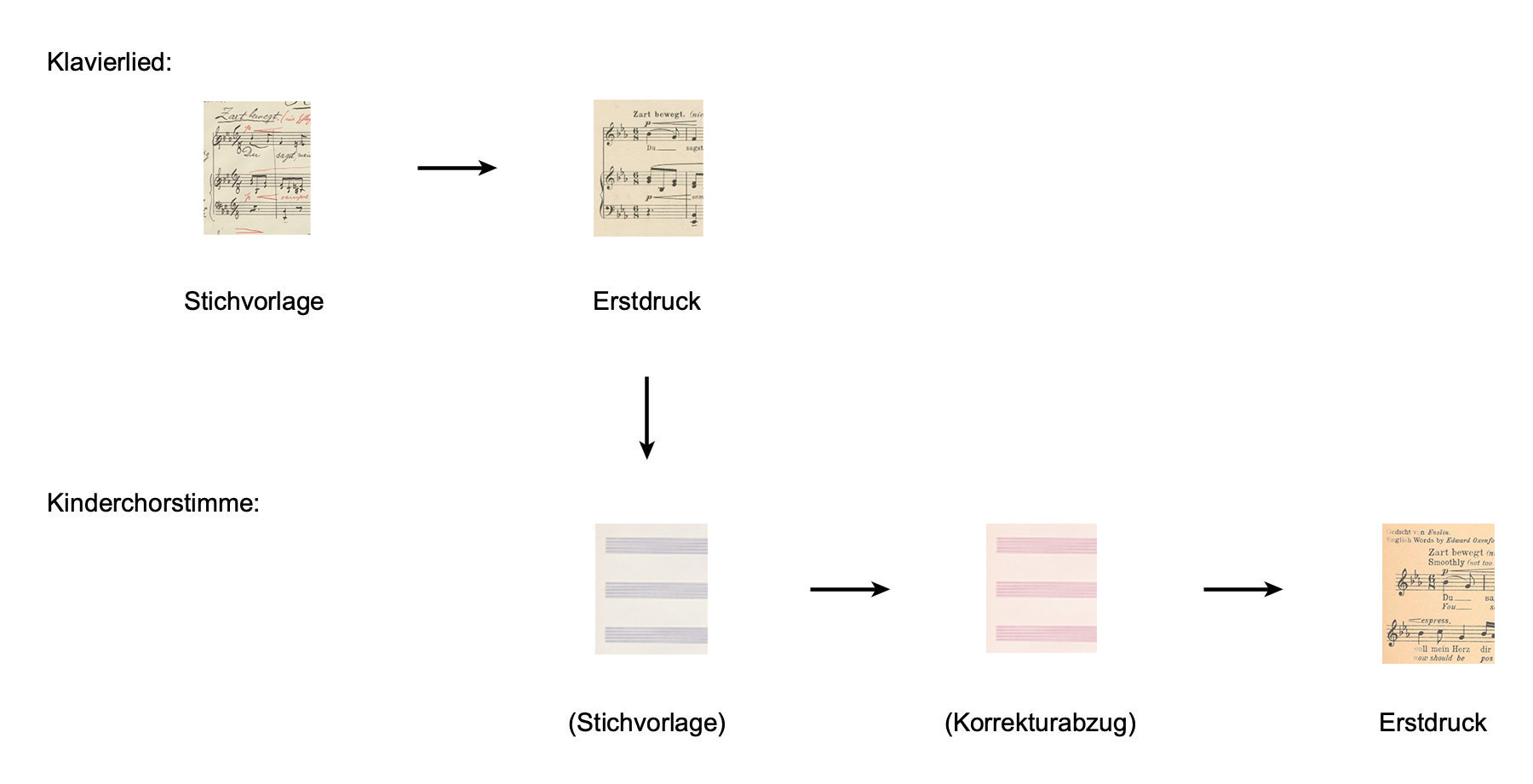Herzenstausch op. 76 No. 5
Version for one-part children’s choir and piano
-
Herzenstausch
Text: Karl Enslin
- -
- Schlichte Weisen op. 76 Bd. I for voice and piano
- -
1.
| Reger-Werkausgabe | Bd. II/10: Werke für Männer-, Frauen- und Kinderchor, S. 168f. |
| Herausgeber | Christopher Grafschmidt und Claudia Seidl. Unter Mitarbeit von Knud Breyer und Stefan König. |
| Verlag | Carus-Verlag, Stuttgart; Verlagsnummer: CV 52.817. |
| Erscheinungsdatum | Oktober 2024. |
| Notensatz | Carus-Verlag, Stuttgart. |
| Copyright | 2024 by Carus-Verlag, Stuttgart and Max-Reger-Institut, Karlsruhe – CV 52.817. Vervielfältigungen jeglicher Art sind gesetzlich verboten. / Any unauthorized reproduction is prohibited by law. Alle Rechte vorbehalten. / All rights reserved. |
| ISMN | 979-0-007-31440-8. |
| ISBN | 978-3-89948-464-9. |
Herzenstausch
[Probably] Karl Enslin: Herzenstausch, in:
Gedichte für das erste Kindesalter, ed. by Ida Seele, Berlin
[Possibly] Nakonz, Guido: 10. Herzenstausch, in:
Kinderlieder für eine Singstimme mit Begleitung des Pianoforte, Leipzig
Copy shown in RWA: DE, Karlsruhe, Max-Reger-Institut/Elsa-Reger-Stiftung, G.
Note: Das abschließende “Herz” hat Reger hinzugefügt.
1. Composition and Publication
When Reger returned on 16 May 1909 from a visit to England, he found waiting for him a letter from a Mr Greiner that had apparently been forwarded by the publishers Bote & Bock. The sender was presumably Albert Greiner, a singing teacher and the director of the Augsburg Singing School that was founded in 1905.1 Greiner was always on the lookout for suitable repertoire2 and had presumably approached Reger’s publisher with a request for an arrangement for children’s choir and piano of Herzenstausch (“Exchange of hearts”) from vol. I of his Schlichte Weisen op. 76. Greiner had already performed Des Kindes Gebet (“The child’s prayer”) op. 76 no. 22 with unison children’s choir at his music school’s annual concert the year before.3
It was presumably at first unclear to Reger as to “what the arrangement should be! i.e. whether unison or in several parts for choir; please get in touch with the gentleman so that he can clarify this for you as soon as possible. The matter would have to proceed as quickly as possible. I would then be perfectly happy to arrange the song”.4 Reger was able to send the manuscript of a unison arrangement to his publisher by 18 May: “Please also find enclosed the song ‘Herzenstausch’. It was requested – if I am not mistaken – in E-flat major. As Mr Greiner writes, no changes are necessary, so I have not altered the vocal parts in the slightest. Needless to say, [I] ask for absolutely no fee for this minimal work. If you can engrave the part straightaway and send me the proof immediately, the whole thing can be seen to in 8 days at most.”5
Reger sent back the proof on 20 May, but with an expression of astonishment: “Röder has engraved the little song ‘Herzenstausch’ in F major!6 Wasn’t it requested in E-flat major? My manuscript is therefore once more enclosed with this letter!”7 There is no evidence of any correspondence between Albert Greiner and the publisher in the meantime. While Reger was still regretting on 23 May that the song had been “engraved in the wrong key” (“Perhaps Mr Greiner can use it like this after all!”),8 this version was ultimately indeed published in E-flat major.9
It is true that the printed part for children’s choir10 does not diverge in any significant way from the original solo song with piano accompaniment. Since Bote & Bock had taken over the publishing business of Lauterbach & Kuhn in late 1908, who had originally published vol. I of the Schlichte Weisen, it is surprising that Reger prepared the manuscript himself, especially since he also left it up to his publisher to formulate the title for this separate part.11
According to an advertising brochure published by Bote & Bock that claims to be complete up to 1 January 1914, a similar arrangement had by this date been published of Des Kindes Gebet (no. 22). However, this was not mentioned in Wilhelm Altmann’s 1917 catalogue of Reger’s works.12 Besides this, prospectuses from around the 1920s onwards also mention Mit Rosen bestreut (“Strewn with roses”, no. 12). No arranger is mentioned for either edition, though as in Reger’s case above, no arranger would really have been necessary. Either way, there is no mention of any arrangement of these two works in Reger’s correspondence.
2.
Translation by Chris Walton.
1. Early reception
The arrangement of Herzenstausch was favourably reviewed by Heinrich Oehlerking, though he refrained from referring back directly to the Schlichte Weisen: “The text is a short, two-stanza poem. Max Reger has captured its childlike, heartfelt tone well with his simple, plain, easily singable manner. Highly recommended for lower and middle classes at girls’ schools.”1
2.
Translation by Chris Walton.
1. Stemma

2. Quellenbewertung
Der Edition liegt als Leitquelle für die Chorstimme der Erstdruck der Kinderchorstimme zugrunde. Aufgrund Regers Aussage, er habe “die Gesangsstimmen […] nicht im Geringsten verändert”,1 kommt den Referenzquellen Erstdruck und Stichvorlage des Klavierlieds eine besondere Bedeutung zu. Für die Klavierstimme wird auf die Edition des Klavierlieds (RWA Bd. II/4) zurückgegriffen.
3. Sources
- Stichvorlage Klavierlied
- Erstdruck Klavierlied
- Erstdruck Kinderchorstimme
Object reference
Max Reger: Herzenstausch op. 76 No. 5, in: Reger-Werkausgabe, www.reger-werkausgabe.de/mri_work_01120.html, version 3.1.1, 31st January 2025.
Information
This is an object entry from the RWA encyclopaedia. Links and references to other objects within the encyclopaedia are currently not all active. These will be successively activated.